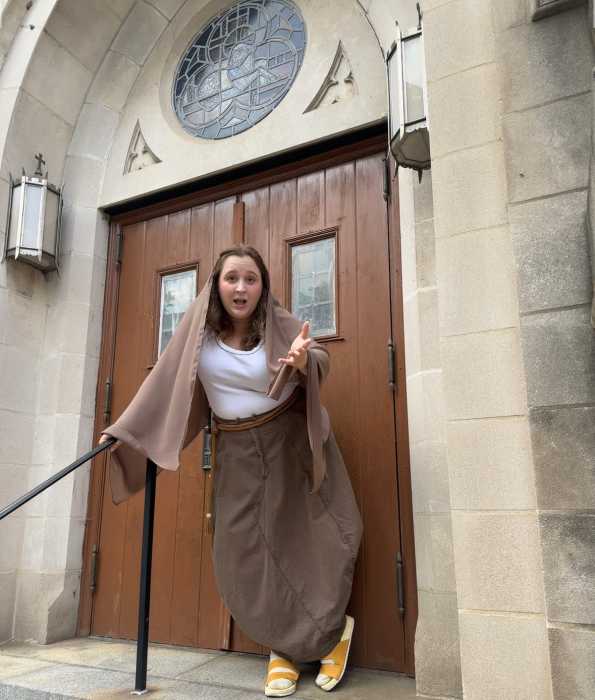This year the 36-year-old, internationally touring, New York City-based Dance on Camera Festival has spread its wings and swept into the boroughs. Expanded content brought opportunities for community-based programming.
Dance on Camera 08 screens at Lincoln Center, Brooklyn, Bronx.
The Festival returns to the Bronx Academy of Arts and Dance (BAAD) with shorts of gay interest. The evening includes a live performance by BAAD artistic director Arthur Aviles.
WATER FLOWING TOGETHER
New York State Theater
Lincoln Center
Jan. 7 at 6:30 p.m.
$7; nycballet.com
BAAD PROGRAM
Bronx Academy of Arts and Dance
841 Barretto St. btwn. Garrison & Lafayette Aves.
# 6 train to Hunts Point
Jan. 10 at 6 p.m., $6
718-842-5223
CELEBRATION OF LOIE FULLER
Berkeley Carroll School
181 Lincoln Pl. btwn. Seventh & Eighth Aves.
Q train to Seventh Ave.,
2,3 to Grand Army Plaza
Jan. 12 at 7 p.m.
718-789-6060
The BAAD shorts range in tone from seething tension in Manivel Damien's black and white, very athletic locker room drama “Viril” to sweetness in Nadia Roden's colorful water ballet for animated sea creatures, to music of Camille Saint-Saens.
A water ballet of a different sort, “Dark Room” by Peter Bebjak, is the longest and grimmest work, yet it fascinates. A septet of men dance in a drained bath. An intense duet with the dancer's mirror image explores the physicality of flesh. Punishing corporeality in duets and solos in a running shower and affecting drama in spoken word solos ring true in the dungeon-like atmosphere.
“Sonata to a Man of Action” is an action-figure animation short by Marta Asparren. A bare-chested toy in kaki chinos moves with seeming kinaesthetic awareness in a muddy set.
The piquant program at BAAD includes offerings from six different countries.
“Water Flowing Together,” a telling biopic on the magnificent, recently retired gay New York City Ballet dancer Jock Soto, will be specially screened at the New York State Theater. Soto is best known for his exquisite partnering. Said Heather Watts, his long-time dance partner, “There are few people who are incapable of making a wrong move. He can do that for two people.”
Mama Jo Soto was the first female hoop dancer in their Navajo clan Water Flowing Together. In that matriarchal society, the young Jock learned to revere women. He danced with hoops at the age of three and then took an interest in ballet, lured in part by the world outside the reservation. He was the only boy in his local school who wanted to take ballet. When he came to New York on a School of American Ballet scholarship, the city was freedom for him. It had everything.
“In the Indian way, a gay person was rather special,” said his mother, “In fact, being gay was lots of times revered. They felt that they were different so they respected gay people.”
At 40, the retiring dancer told how his tendons are giving out from lifting ballerinas. His confessions at the close of his performing career recall the poignancy in “Man Who Dances Edward Villella,” a filmed day-in-the-life when that great dancer collapsed on stage from overwork.
After the screening, Soto talks with director Gwendolyn Cates on the stage where he performed for 25 years. There will be additional screenings, and talkbacks at the Walter Reade Theater on January 11 and 18 at 8:30 p.m. ($11, $7 for students at Filmlinc.
The Film Society of Lincoln Center's 14 programs, co-produced with Dance Films Association, screen at the Walter Reade. DFA organized the Bronx BAAD evening, another at Spoke-the-Hub in Red Hook, and a Loie Fuller event in Park Slope.
This past year, two books were published on the turn-of-the-century dancer and choreographer Fuller – Rhonda Garelick's “Electric Salome,” and Ann Cooper Albright's “Traces of Light.” The authors converge with choreographer and foremost Fuller-style interpreter Jody Sperling at the Berkeley Carroll School in Park Slope on the January 12. The celebration of Fuller includes a live performance by Sperling, discussion, and a screening.
Fuller is considered a progenitor of cinematography. Her expertise with lighting and projection technology was considered “male” in her day. She was known publicly as a lesbian. At the same time, hers was a “a highly feminized performative sexuality,” wrote Albright. Her 1921 dance film “Le lys de la vie” is her queer culmination. She is immortalized in fin de siecle decorative art nouveau.































